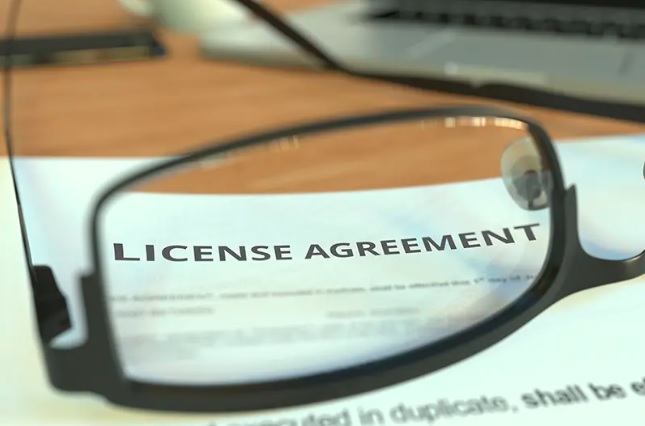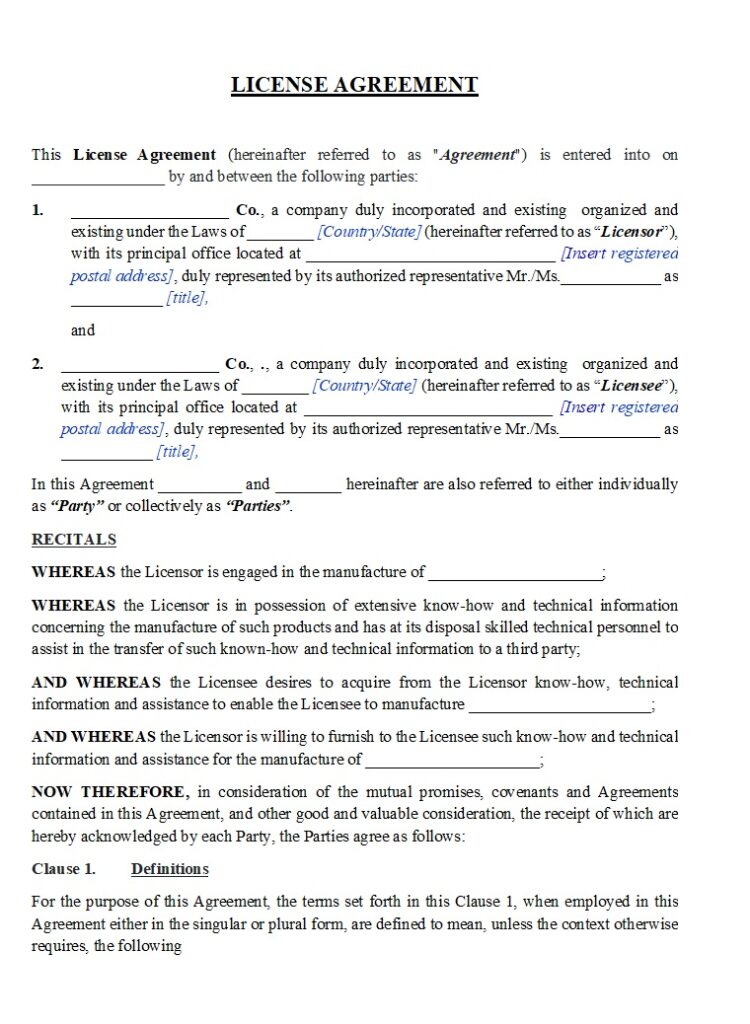Estimated reading time: 5 minutes
What is a License Agreement?
When an individual or company creates some new intellectual property, it has the right to protect that invention, slogan, or creation by preventing others from using or profiting from it. Anyone who uses the new intellectual property is liable for infringement, unless first the conditions of a License Agreement have been negotiated to transfer rights and make what would be considered “infringement” into a permitted use.

How Licensing Agreements Work
Licensing Agreements are particularly important to clients in the manufacturing, computer software and home theater industries, and the fashion and jewelry industries. A License Agreement sets forth the rights and obligations of each party: the Licensor and the Licensee.
License Agreement Components
A License Agreement involves many components that, together, comprise a complete License Agreement. Each of these parts of the License Agreement is independently negotiable and, depending on whether you are Licensor or Licensee. Whether you have a strong negotiating position or a more moderate one, will determine how hard you may push on one or more of the components to obtain a License that is more favorable to your position.
Here are the major components of most License Agreements (not only are each of these negotiable, they each are also non-mandatory; that is, a License might, or might not, have each one of these):
Exclusivity
A License may be “exclusive” or “non-exclusive” depending on whether the owner of the rights wants to permit only one, or more than one, person or entity to practice the intellectual property that is subject to the License. Typically, if the License is “exclusive”, then the Licensee will pay more to the Licensor, and also will be able to enforce the intellectual property rights against infringers in the name of the Licensee.
In a “non-exclusive” License, normally the Licensor must be the one to file the infringement litigation in the name of the Licensor. Although in either situation, the Licensor and the Licensee can share the expenses and/or the proceeds, depending on what is written into the License Agreement, if anything.
Territory
A license can apply locally or globally. Many times, the Licensee expresses a desire for a “World-Wide” License.
In reality, no such thing exists. All Patent and Trademark rights remain territorial. A Patent or Trademark protects rights only in one country, and the applicant must file separately in each country.
The Berne Convention generally covers Copyrights, so people often argue they are “worldwide.” However, practical complications often prevent that from happening. Any given License may also impose territorial restrictions on where a Licensee can sell. Non-Exclusive Licenses usually include these limits, where each Licensee gains exclusive rights within a region of the U.S. or the world, but cannot sell outside that assigned region.
License Fee
Some licenses require the Licensee to pay an up-front fee (“License Fee”) to secure the license. This often occurs when the product is highly desirable, when multiple non-exclusive licensees compete, and when obtaining a License itself becomes competitive. In some cases, the Licensee credits the up-front fee against future Royalties earned from sales. In other cases, the Licensee pays the fee entirely in addition to actual Royalties. Once again, both parties can negotiate every detail.
Royalties
Royalties may equal a percentage of the selling price of each unit or a fixed amount per unit sold. Sometimes a License requires a set payment, regardless of actual sales of the Licensed product. Typically, the Licensee owes Royalties based on the sales volume during a given period. The Licensee must also provide a Royalty Report that lists units sold, prices, returns, and any other factors affecting the calculation.
Guaranteed Royalties
Normally, the Licensee pays Royalties only when sales occur. However, that structure can allow a Licensee to lock rights without making sales. To prevent this, some Licenses require the Licensee to pay a “Guaranteed Royalty,” usually a “Guaranteed Minimum Royalty.” The Licensee credits the Guaranteed Minimum against actual earned Royalties. If the Licensee earns more than the minimum, it must pay the additional Royalties as well.
Sub-Licenses
Each License has an option of permitting the Licensee to “sub-license” or not. In a situation where a Licensee may “sub-license”, each License has an option that the Licensor will profit from the individual Sub-Licensee’s sales or only from the Licensee’s aggregate sales. There may or may not be privity of contract between the Licensor and the Sub-Licensee, and there might be requirements, such as territorial restrictions and/or the ability to further Sub-License the Intellectual Property Rights. All of this can — and should — be discussed further with the Attorneys.
Advantages of Having a Licensing Agreement
The advantages of licensing a product are many, including:
- Field of Use Restrictions can pertain to the specific segment of the industry in which a Licensee may sell products.
- Control who uses the product or process.
- Limit the license on a software product to one user, requiring the payment of a licensing fee on the transfer of the product.
- Limit where and how a product is used. For example, a license on the logo of a professional sports team may limit the type of product on which the logo may appear.
Check out more pages of our website for related content:
Access the Full Contract Directory Index
You can browse the complete alphabetical list of all commercial, financial, and project-based contract templates by visiting our A–Z Contract Index.
References
has been added to your cart!
have been added to your cart!



